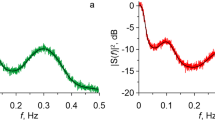Abstract
The analysis of heart rate variability, involving changes in the autonomic modulation conditions, demands specific capabilities not provided by either parametric or non-parametric spectral estimation methods. Moreover, these methods produce time-averaged power estimates over the entire length of the record. Recently, empirical mode decomposition and the associated Hilbert spectra have been proposed for non-linear and non-stationary time series. The application of these techniques to real and simulated short-term heart rate variability data under stationary and non-stationary conditions is presented. The results demonstrate the ability of empirical mode decomposition to isolate the two main components of one chirp series and three signals simulated by the integral pulse frequency modulation model, and consistently to isolate at least four main components localised in the autonomic bands of 14 real signals under controlled breathing manoeuvres. In addition, within the short time-frequency range that is recognised for heart rate variability phenomena, the Hilbert amplitude component ratio and the instantaneous frequency representation are assessed for their suitability and accuracy in time-tracking changes in amplitude and frequency in the presence of non-stationary and non-linear conditions. The frequency tracking error is found to be less than 0.22% for two simulated signals and one chirp series.
Similar content being viewed by others
References
Bayly, E. (1968): ‘Spectral analysis of pulse frequency modulation in the nervous systems’,IEEE Trans. Biomed. Eng.,15, pp. 257–265
Berger, R., Akselrod, S., Gordon, D., andCohen, R., (1986): ‘An efficient algorithm for spectral analysis of heart rate variability’,IEEE Trans. Biomed. Eng.,33, pp. 900–904
Boashash, B. (1992): ‘Estmating and interpreting the instantaneous frequency of a signal-part 2: algorithms and applications’,Proc. IEEE,80, pp. 540–568
Brown, T., Breghtol, L., Koh, J., andEckberg, D. (1993): ‘Important influence of respiration on human R-R interval power spectra is largely ignored’,J. Appl. Physiol.,75, pp.2310–2317
Chan, H., Lin, J., Huang, H., andWu, C. (1997): ‘Elimination of interference component in Wigner-Ville distribution for the signal with 1/f spectral characteristic’,IEEE Trans. Biomed. Eng.,44, pp. 903–907
Cohen, L. (1995): ‘Time-frequency analysis’ (Prentice Hall, Englewood Cliffs, NJ), pp. 1–43
Cooke, W., Hoag, J., Crossman, A., Kuusela, T., Tahvanainen, K., andEckberg, D. (1999): ‘Human responses to upright tilt: a window on central autonomic integration’,J. Physiol.,517, pp. 617–628
De Boer, R., Karemaker, J., andStrackee, J. (1985): ‘Spectrum of a series of point events, generated by the integral pulse frequency modulation model’,Med. Biol. Eng. Comput.,23, pp. 138–142
Echeverría, J., Medina, V., andCarrasco, S. (1997): ‘A comparison between the peak ear pulse derivative and the R-R interval variabilities’Comput. Cardiol.,24, pp. 445–447
Eckberg, D. (1996): ‘Sympathovagal balance. A critical appraisal’,Circulation,96, pp. 3226–3232
Goldberger, A., Amaral, L., Glass, L., Hausdorff, J., Ivanov, P., Mark, R., Mietus, J., Moody, G., Peng, C., andStanly, E. (2000): ‘PhysioBank, PhysioToolkit, and PhysioNet. Components of a new research resource for complex physiological signals’,Circulation,101, pp. e215-e220
Huang, N., Shen, Z., Long, S., Wu, M., Shih, H., Zheng, Q., Yen, N., Tung, C., andLiu, H. (1998): ‘The empirical mode decomposition and the Hilbert spectrum for nonlinear and non-stationary time series analysis’,Proc. R. Soc. London,454, pp. 903–995
Karemaker, J. (1999): ‘Autonomic integration: the physiological basis of cardiovascular variability,’J. Physiol.,517, p. 316
Kobayashi, M., andMusha, T. (1982): ‘1/f fluctuations of heartbeat period’,IEEE Trans. Biomed. Eng.,29, pp. 456–457
Mainardi, L., Bianchi, A., Baselli, G., andCerruti, S. (1995): ‘Pole-tracking algorithm for the extraction of time-variant heart rate variability spectral parameters’,IEEE Trans. Biomed. Eng.,42, pp. 250–259
Malliani, A., Pagani, M., Lombardi, F., andCerruti, S. (1991): ‘Cardiovascular neural regulation explored in the frequency domain’,Circulation,84, pp. 482–492
Nakao, M., Norimatsu, M., Mizutani, Y., andYamamoto, M. (1997): ‘Spectral distortions properties of the Integral Pulse Frequency Modulation Model’,IEEE Trans. Biomed. Eng.,44, pp. 419–426
Saul, P., Albrecht, P., Berger, R., andCohen, R. (1988): ‘Analysis of long term heart rate variability: methods, 1/f scaling and implications,’Comput. Cardiol., pp. 419–422
Schechtman, V., Kluge, K., andHarper, R. (1988): ‘Time-domain system for assessing variation in heart rate’,Med. Biol. Eng. Comput.,26, pp. 367–373
Shin, S., Tapp, W., Resman, S., andNatelson, B. (1989): ‘Assessment of autonomic regulation of heart rate variability by the method of complex demodulation’,IEEE Trans. Biomed. Eng.,36, pp. 274–283
Steenis, H., Tulen, J., andMulder, L. (1994): ‘Heart rate variability spectra based on non-equidistant sampling: the spectrum of counts and the instantaneous heart rate spectrum’,Med. Eng. Phys.,16, pp. 355–362
Stein, P., andKleiger, R. (1999): ‘Insights from the study of the heart rate variability’,Ann. Rev. Med.,50, pp. 249–261
Task Force European Society of Cardiology and North American Society of Pacing Electrophysiology (1996): ‘Heart rate variability. Standards of measurement, physiological interpretation, and clinical use’,Europ. Heart J.,17, pp. 354–381
Yamamoto, Y., andHughson, R. (1991): ‘Coarse-graining spectral analysis: new method for studying heart rate variability’,J. Appl. Physiol.,71, pp. 1143–1150
Author information
Authors and Affiliations
Corresponding author
Rights and permissions
About this article
Cite this article
Echeverría, J.C., Crowe, J.A., Woolfson, M.S. et al. Application of empirical mode decomposition to heart rate variability analysis. Med. Biol. Eng. Comput. 39, 471–479 (2001). https://doi.org/10.1007/BF02345370
Received:
Accepted:
Issue Date:
DOI: https://doi.org/10.1007/BF02345370




